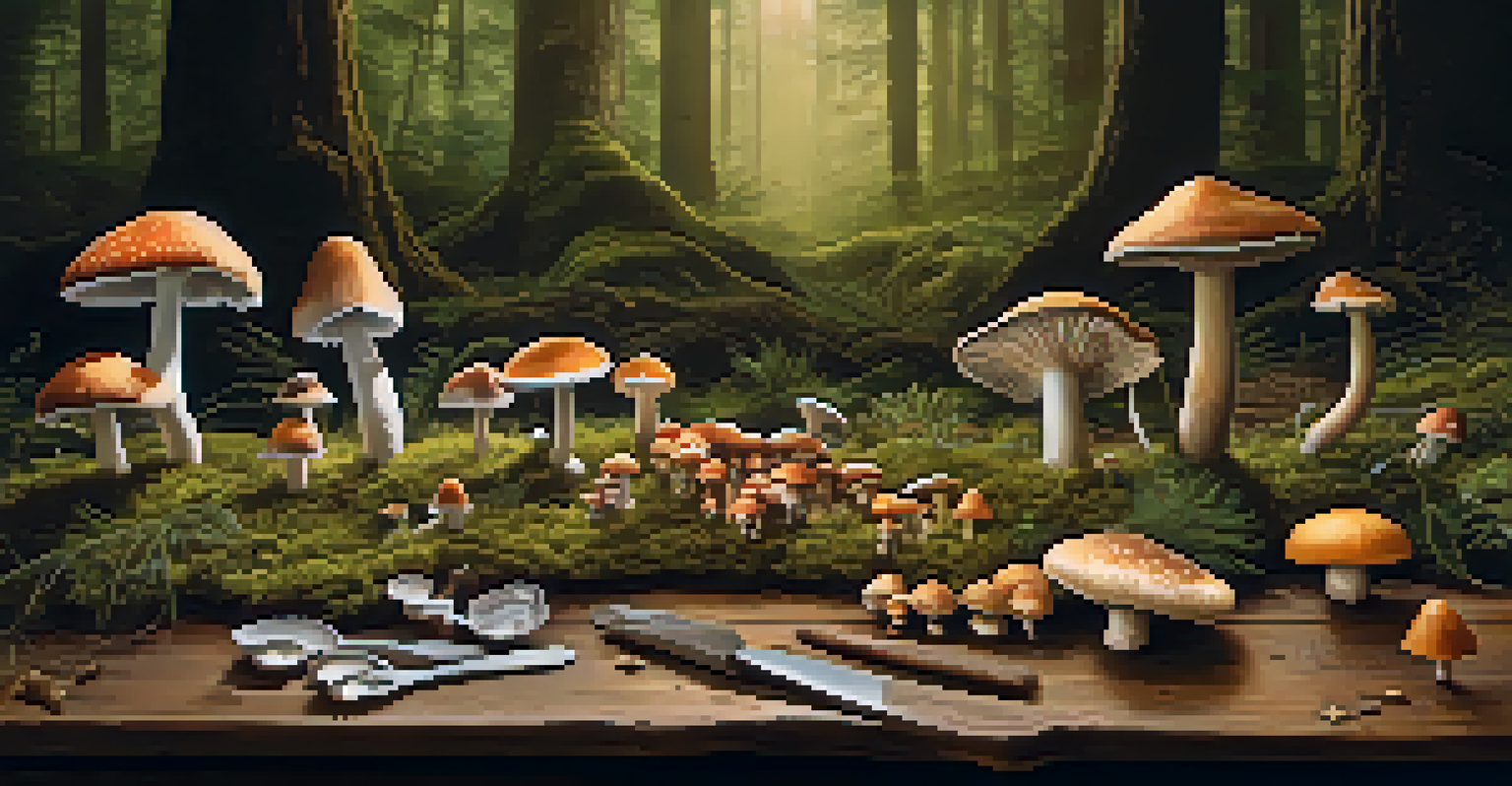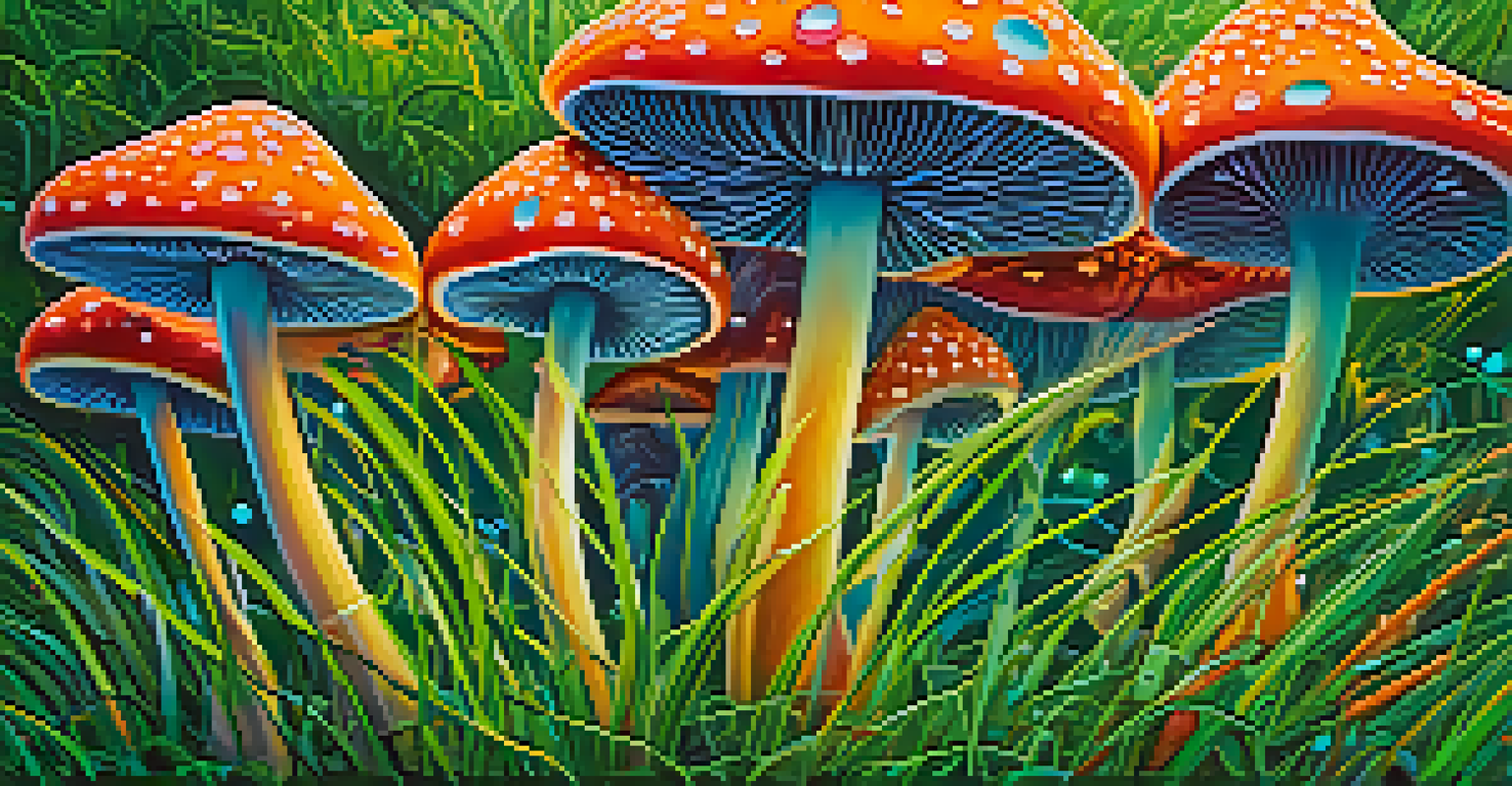Understanding Hallucinogens: A Scientific Overview of Effects

What Are Hallucinogens? A Basic Introduction
Hallucinogens are a class of substances that alter perception, mood, and various cognitive processes. Common examples include LSD, psilocybin mushrooms, and DMT. These substances can lead to profound changes in sensory experiences, creating vivid images, sounds, and even feelings that aren't present in reality.
I think that the biggest changes in my life have come from psychedelic experiences.
These effects arise from the way hallucinogens interact with neurotransmitters in the brain, particularly serotonin. By binding to serotonin receptors, these substances can disrupt normal patterns of perception and cognition. This disruption can result in an altered state of consciousness, often described as a 'trip.'
Understanding what hallucinogens are is the first step in exploring their complex effects. While they have been used historically in various cultures for spiritual purposes, modern science is uncovering both their potential benefits and risks.
How Hallucinogens Affect the Brain
Hallucinogens primarily affect the brain's serotonin system. Serotonin is a neurotransmitter that plays a key role in regulating mood, perception, and cognition. By mimicking serotonin, hallucinogens can create intense sensory experiences and emotional reactions.

When hallucinogens bind to serotonin receptors, particularly the 5-HT2A receptor, they can lead to altered thoughts and perceptions. This can manifest as visual or auditory hallucinations, where users might see colors more vividly or hear sounds that aren't there.
Hallucinogens Alter Perception
Hallucinogens like LSD and psilocybin significantly change sensory experiences and emotional states by interacting with the brain's serotonin system.
Understanding these mechanisms helps clarify why hallucinogens can lead to both positive experiences, like feelings of connectedness, and negative experiences, such as anxiety or paranoia. The brain's response varies significantly from person to person, influenced by factors like dosage, environment, and individual mental health.
The Different Types of Hallucinogens
Hallucinogens can be categorized into two main groups: classic hallucinogens and dissociative drugs. Classic hallucinogens include substances like LSD and psilocybin, which primarily affect perception and sensory experiences. On the other hand, dissociatives, such as ketamine and PCP, can create feelings of detachment from reality.
Hallucinogens can be a kind of mirror. They can show you what you are already feeling, but you may not be aware of it.
Each type of hallucinogen produces distinct effects. For example, LSD is known for visual distortions and a sense of euphoria, while ketamine may induce a sense of floating or out-of-body experiences. Understanding these distinctions is crucial for anyone exploring these substances.
Additionally, there are naturally occurring hallucinogens, like peyote and ayahuasca, which have been used in traditional rituals for centuries. These natural substances often carry cultural significance and are used in specific contexts, highlighting the diverse ways humans have interacted with hallucinogens throughout history.
Short-Term Effects of Hallucinogens
The short-term effects of hallucinogens can vary widely, often depending on the type of substance and the individual's mindset. Users may experience heightened sensory perception, altered sense of time, and intense emotional responses. For some, this can lead to feelings of euphoria, while others may find themselves in a state of anxiety.
Physical effects can also occur, including dilated pupils, increased heart rate, and changes in blood pressure. These physiological changes can amplify the emotional and perceptual effects, creating a unique experience that can be both exhilarating and unsettling.
Therapeutic Uses of Hallucinogens
Research indicates that hallucinogens may offer therapeutic benefits for mental health conditions such as PTSD and anxiety when used in controlled settings.
It's essential to approach hallucinogens with caution, as the unpredictable nature of these short-term effects can lead to challenging experiences, commonly referred to as 'bad trips.' Being in a safe, supportive environment can help mitigate some of these risks.
Long-Term Effects and Risks of Hallucinogens
While many users report positive experiences, there are potential long-term effects associated with hallucinogen use. Some individuals may experience persistent changes in perception, known as Hallucinogen Persisting Perception Disorder (HPPD), where visual disturbances can recur long after the drug has worn off.
Additionally, the risk of psychological distress may increase, especially in individuals with a predisposition to mental health issues. Experiences of anxiety, paranoia, and even psychosis can arise, particularly with frequent or high-dose use.
Understanding these risks is crucial for anyone considering the use of hallucinogens. Responsible use, informed by knowledge of both the effects and potential consequences, can help individuals make safer choices.
Therapeutic Potential of Hallucinogens
Recent research has highlighted the potential therapeutic benefits of certain hallucinogens, particularly in treating conditions like PTSD, depression, and anxiety. Studies suggest that substances like psilocybin can foster profound emotional breakthroughs, helping individuals process trauma and gain new perspectives.
Therapeutic sessions often involve guided experiences, where trained professionals help individuals navigate their journeys. This supportive framework can enhance the positive aspects of the experience while minimizing potential risks.
Cultural Significance of Use
Hallucinogens have a rich history in various cultures as tools for spiritual healing, emphasizing the importance of context in their use.
As the field of psychedelic therapy grows, more clinical trials are emerging to explore these substances' efficacy and safety. This shift signals a growing recognition of the potential value of hallucinogens in mental health treatment.
Cultural and Historical Context of Hallucinogen Use
Hallucinogens have played significant roles in various cultures throughout history. Indigenous peoples, for instance, have used substances like peyote and ayahuasca in spiritual ceremonies for centuries, viewing them as tools for healing and connection to the divine.
These traditional practices often emphasize set and setting—factors that influence the experience. The communal aspect of these rituals can provide a sense of safety and purpose, contrasting sharply with modern recreational use.

Understanding the cultural context of hallucinogen use enriches our perspective on these substances. It highlights the importance of respect and intention when exploring their effects, encouraging a more holistic approach to their use.